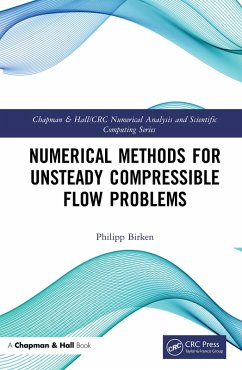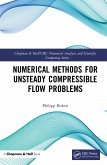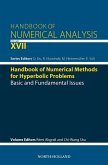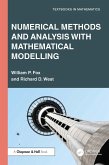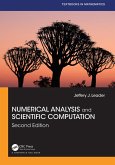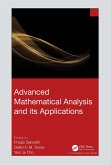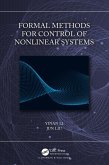Numerical Methods for Unsteady Compressible Flow Problems (eBook, ePUB)


Alle Infos zum eBook verschenken

Numerical Methods for Unsteady Compressible Flow Problems (eBook, ePUB)
- Format: ePub
- Merkliste
- Auf die Merkliste
- Bewerten Bewerten
- Teilen
- Produkt teilen
- Produkterinnerung
- Produkterinnerung

Hier können Sie sich einloggen

Bitte loggen Sie sich zunächst in Ihr Kundenkonto ein oder registrieren Sie sich bei bücher.de, um das eBook-Abo tolino select nutzen zu können.
Numerical Methods for Unsteady Compressible Flow Problems is written to give both mathematicians and engineers an overview of the state of the art in the field, as well as of new developments. The focus is on methods for the compressible Navier-Stokes equations, the solutions of which can exhibit shocks, boundary layers and turbulence. The idea of the text is to explain the important ideas to the reader, while giving enough detail and pointers to literature to facilitate implementation of methods and application of concepts.
The book covers high order methods in space, such as…mehr
- Geräte: eReader
- mit Kopierschutz
- eBook Hilfe
![Numerical Methods for Unsteady Compressible Flow Problems (eBook, PDF) Numerical Methods for Unsteady Compressible Flow Problems (eBook, PDF)]() Philipp BirkenNumerical Methods for Unsteady Compressible Flow Problems (eBook, PDF)46,95 €
Philipp BirkenNumerical Methods for Unsteady Compressible Flow Problems (eBook, PDF)46,95 €![Defect Correction Methods for Fluid Flows at High Reynolds Numbers (eBook, ePUB) Defect Correction Methods for Fluid Flows at High Reynolds Numbers (eBook, ePUB)]() Alexander E. LabovskyDefect Correction Methods for Fluid Flows at High Reynolds Numbers (eBook, ePUB)52,95 €
Alexander E. LabovskyDefect Correction Methods for Fluid Flows at High Reynolds Numbers (eBook, ePUB)52,95 €![Handbook of Numerical Methods for Hyperbolic Problems (eBook, ePUB) Handbook of Numerical Methods for Hyperbolic Problems (eBook, ePUB)]() Handbook of Numerical Methods for Hyperbolic Problems (eBook, ePUB)120,95 €
Handbook of Numerical Methods for Hyperbolic Problems (eBook, ePUB)120,95 €![Numerical Methods and Analysis with Mathematical Modelling (eBook, ePUB) Numerical Methods and Analysis with Mathematical Modelling (eBook, ePUB)]() William P. FoxNumerical Methods and Analysis with Mathematical Modelling (eBook, ePUB)72,95 €
William P. FoxNumerical Methods and Analysis with Mathematical Modelling (eBook, ePUB)72,95 €![Numerical Analysis and Scientific Computation (eBook, ePUB) Numerical Analysis and Scientific Computation (eBook, ePUB)]() Jeffery J. LeaderNumerical Analysis and Scientific Computation (eBook, ePUB)56,95 €
Jeffery J. LeaderNumerical Analysis and Scientific Computation (eBook, ePUB)56,95 €![Advanced Mathematical Analysis and its Applications (eBook, ePUB) Advanced Mathematical Analysis and its Applications (eBook, ePUB)]() Advanced Mathematical Analysis and its Applications (eBook, ePUB)206,95 €
Advanced Mathematical Analysis and its Applications (eBook, ePUB)206,95 €![Formal Methods for Control of Nonlinear Systems (eBook, ePUB) Formal Methods for Control of Nonlinear Systems (eBook, ePUB)]() Yinan LiFormal Methods for Control of Nonlinear Systems (eBook, ePUB)41,95 €
Yinan LiFormal Methods for Control of Nonlinear Systems (eBook, ePUB)41,95 €-
-
-
The book covers high order methods in space, such as Discontinuous Galerkin methods, and high order methods in time, in particular implicit ones. A large part of the text is reserved to discuss iterative methods for the arising large nonlinear and linear equation systems. Ample space is given to both state-of-the-art multigrid and preconditioned Newton-Krylov schemes.
Features
- Applications to aerospace, high-speed vehicles, heat transfer, and more besides
- Suitable as a textbook for graduate-level courses in CFD, or as a reference for practitioners in the field
Dieser Download kann aus rechtlichen Gründen nur mit Rechnungsadresse in A, B, BG, CY, CZ, D, DK, EW, E, FIN, F, GR, HR, H, IRL, I, LT, L, LR, M, NL, PL, P, R, S, SLO, SK ausgeliefert werden.
- Produktdetails
- Verlag: Taylor & Francis eBooks
- Seitenzahl: 246
- Erscheinungstermin: 4. Juli 2021
- Englisch
- ISBN-13: 9781000403541
- Artikelnr.: 62014622
- Verlag: Taylor & Francis eBooks
- Seitenzahl: 246
- Erscheinungstermin: 4. Juli 2021
- Englisch
- ISBN-13: 9781000403541
- Artikelnr.: 62014622
- Herstellerkennzeichnung Die Herstellerinformationen sind derzeit nicht verfügbar.
Notation. 1.4. Outline. 2. The Governing Equation. 2.1. The Navier-Stokes
Equations. 2.2. Nondimensionalization. 2.3. Source terms. 2.4.
Simplifications of the Navier-Stokes equations. 2.5. The Euler Equations.
2.6. Solution theory. 2.7. Boundary layers. 2.8. Boundary layers. 2.9.
Laminar and turbulent flows. 3. The Space discretization. 3.1. Structured
and unstructured Grids. 3.2. Finite Volume Methods. 3.3. The Line Integrals
and Numerical Flux Functions. 3.4 Convergence theory for finite volume
methods. 3.5. Source Terms. 3.6. Finite volume methods of higher order.
3.7. Discontinuous Galerkin methods. 3.8. Convergence theory for DG
methods. 3.9. Boundary Conditions. 3.10. Spatial Adaptation. 4. Time
Integration Schemes. 4.1. Order of convergence and order of consistency.
4.2 Stability. 4.3. Stiff problems. 4.4. Backward Differentiation formulas.
4.5. Runge-Kutta methods. 4.6. Rosenbrock-type methods. 4.7. Adaptive time
step size selection. 4.8. Operator Splittings. 4.9. Alternatives to the
method of lines. 4.10. Parallelization in time. 5. Solving equation
systems. 5.1. The nonlinear systems. 5.2. The linear systems. 5.3. Rate of
convergence and error. 5.4. Termination criteria. 5.5. Fixed Point methods.
5.6. Multigrid methods. 5.7. Newton's method. 5.8. Krylov subspace methods.
5.9. Jacobian Free Newton-Krylov methods. 5.10. Comparison of GMRES and
BiCGSTAB. 5.11. Comparison of variants of Newton's method. 6.
Preconditioning linear systems. 6.1. Preconditioning for JFNK schemes. 6.2.
Specific preconditioners. 6.3. Preconditioning in parallel. 6.4. Sequences
of linear systems. 6.5. Discretization for the preconditioner. 7. The final
schemes. 7.1. DIRK scheme. 7.2. Rosenbrock scheme. 7.3. Parallelization.
7.4. Efficiency of Finite Volume schemes. 7.5. Efficiency of Discontinuous
Galerkin schemes. 8. Thermal Fluid Structure Interaction. 8.1. Gas
Quenching. 8.2. The mathematical model. 8.3. Space discretization. 8.4.
Coupled time integration. 8.5. Dirichlet-Neumann iteration. 8.6.
Alternative solvers. 8.7. Numerical Results. A. Test problems. A.1.
Shu-Vortex. A.2. Supersonic Flow around a cylinder. A.3. Wind Turbine. A.4.
Vortex shedding behind a sphere. B. Coefficients of time integration
methods. Bibliography. Index.
Notation. 1.4. Outline. 2. The Governing Equation. 2.1. The Navier-Stokes
Equations. 2.2. Nondimensionalization. 2.3. Source terms. 2.4.
Simplifications of the Navier-Stokes equations. 2.5. The Euler Equations.
2.6. Solution theory. 2.7. Boundary layers. 2.8. Boundary layers. 2.9.
Laminar and turbulent flows. 3. The Space discretization. 3.1. Structured
and unstructured Grids. 3.2. Finite Volume Methods. 3.3. The Line Integrals
and Numerical Flux Functions. 3.4 Convergence theory for finite volume
methods. 3.5. Source Terms. 3.6. Finite volume methods of higher order.
3.7. Discontinuous Galerkin methods. 3.8. Convergence theory for DG
methods. 3.9. Boundary Conditions. 3.10. Spatial Adaptation. 4. Time
Integration Schemes. 4.1. Order of convergence and order of consistency.
4.2 Stability. 4.3. Stiff problems. 4.4. Backward Differentiation formulas.
4.5. Runge-Kutta methods. 4.6. Rosenbrock-type methods. 4.7. Adaptive time
step size selection. 4.8. Operator Splittings. 4.9. Alternatives to the
method of lines. 4.10. Parallelization in time. 5. Solving equation
systems. 5.1. The nonlinear systems. 5.2. The linear systems. 5.3. Rate of
convergence and error. 5.4. Termination criteria. 5.5. Fixed Point methods.
5.6. Multigrid methods. 5.7. Newton's method. 5.8. Krylov subspace methods.
5.9. Jacobian Free Newton-Krylov methods. 5.10. Comparison of GMRES and
BiCGSTAB. 5.11. Comparison of variants of Newton's method. 6.
Preconditioning linear systems. 6.1. Preconditioning for JFNK schemes. 6.2.
Specific preconditioners. 6.3. Preconditioning in parallel. 6.4. Sequences
of linear systems. 6.5. Discretization for the preconditioner. 7. The final
schemes. 7.1. DIRK scheme. 7.2. Rosenbrock scheme. 7.3. Parallelization.
7.4. Efficiency of Finite Volume schemes. 7.5. Efficiency of Discontinuous
Galerkin schemes. 8. Thermal Fluid Structure Interaction. 8.1. Gas
Quenching. 8.2. The mathematical model. 8.3. Space discretization. 8.4.
Coupled time integration. 8.5. Dirichlet-Neumann iteration. 8.6.
Alternative solvers. 8.7. Numerical Results. A. Test problems. A.1.
Shu-Vortex. A.2. Supersonic Flow around a cylinder. A.3. Wind Turbine. A.4.
Vortex shedding behind a sphere. B. Coefficients of time integration
methods. Bibliography. Index.
